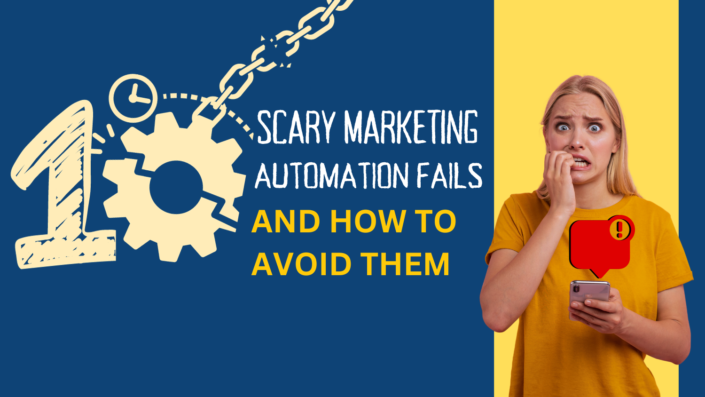It goes by many names: Murphy’s Law, the Second Law of Thermodynamics, or Finagle’s constant. Whatever it’s called, we’re all painfully aware of it. Anything that can go wrong will go wrong. Put another way, things can and do break. That’s just how the universe works.
This rule particularly rings true when it comes to marketing automation platforms (MAPs). While MAPs continue to see some pretty decent adoption rates (around 51% of companies, according to some sources), marketers still encounter significant difficulties with their MAP and struggle to get the most out of their tech stacks—oftentimes with disastrous results. Problems like a lack of clear strategy, the inherent complexity of MAPs, persistent data quality issues, and inadequate technical skills—if left unnoticed and/or unresolved—turn MAPs into ticking time bombs.
That’s why slightly over 6 in 10 marketers claim they’ve experienced technical hitches in setting up and maintaining their MAP. So, there’s better than a 50/50 chance you’re going to hit some snags with your MAP implementation, too. In fact, if things are going too smoothly, that’s a sign something’s wrong. It’s just a matter of time before a hidden MAP flaw becomes a full-blown marketing catastrophe. Here are 10 ways how.
1. The “Hi FirstName” personalization fail
This is a classic example of personalization gone wrong. Practically all of us have at one point opened an email and found a unmodified first name tag where we’d expect to see our names. This blunder seems to happen all the time and also involves other personalization fields such as company names, industry, location, etc. Most experts believe that every marketer has made this mistake at least once in their careers.
MAPs enable greater levels of personalization when done right. The problem is that automation only worsens issues created by poor personalization strategies and capabilities. Marketers need richer data to fill out the personalization fields in their marketing materials, plus added oversight to ensure the copy/message works as intended.
So, if you have neither the time nor the resources, it’s wiser to keep personalization down to a minimum. In some cases, having no personalization whatsoever trumps any half-baked attempt at making messages relevant.
Related: How to Get Quality IT Appointments Hands-Free with Marketing Automation
2. Out-of-control auto-replies
Automation frees up time and people, so that these resources are put to work on more important things. But time savings and productivity gains from automation don’t always justify keeping humans out of the loop in some marketing touch points.
Social media marketing, for example, calls for balancing automation and personal touch. MAPs work well at scheduling posts, optimizing reach, and curating content. But there’s no substitute for person-to-person interaction when it comes to engaging with and responding to your community.
Over the years, a string of embarrassing brand slipups continues to prove that social media auto-replies are a bad idea. These gaffes range from ill-timed canned responses to outright offensive posts. To avoid making these MAP mistakes altogether, a good rule-of-thumb is to let machines do the boring tasks and just simply leave the exciting stuff to people.
3. Leads disappearing into thin air
MAPs exist to help you efficiently move leads down the conversion funnel, so losing track of prospects defeats the whole point of automation in the first place. That’s why lead management ranks as one of the top benefits that marketers expect from MAPs.
One of the most powerful features that good MAPs offer is the ability to integrate web data into other channels. A prospect’s browsing behavior on your website can tell you a lot about interest and intent. Surprisingly, a lot of marketers tend to overlook this “send and respond” MAP capability for any number of reasons.
The problem of tracking and managing leads with MAPs will only continue to get worse, especially given that half of MAP users cite technology integration complexity as their biggest obstacle to success. But this doesn’t mean that the situation is hopeless. One effective workaround is as simple as tagging your website with code to monitor page views and navigation.
Related: The 4 Main Lead Generation Goals: What Has Changed & How to Reach Them
4. Touch points turning into WMDs
Some 60% of marketers claim they’ve been more focused on improving audience segmentation and personas with the help of their MAPs.
That’s, of course, hardly surprising, since the ability to send contextual and relevant messages makes up a typical MAP’s UVP.
Despite this, more than 4 in 10 marketers still don’t use any targeting at all, and another third use only limited segmentation criteria. That’s a massive waste of what MAPs are capable of. Rather than a tool for carrying out timely and precise communications, MAPs have now become weapons of mass distraction.
If MAP users don’t target or segment, it’s not for lack of trying. A full 38% of marketers say inadequate contact data quality hinders them from reaping the full benefits of their tech stacks—which brings us to our next point.
5. Campaigns haunted by bad data
Bad data impacts MAPs in nasty (and often insidious) ways. Poor data quality results in unreliable metrics, imprecise targeting/segmentation, incorrect personalization (recall point #1), and lower overall lead quality. For email automation alone, bad data wreaks havoc on sender scores, deliverability, CTRs, bounces, and opt-outs.
All of this costs money. According to the 1:10:100 rule, it takes $1 to prevent bad data, $10 to fix it, and $100 if it remains undetected. Sources estimate that anywhere between a quarter to a third of database records go stale each year. That’s why bad data eats up as much as 12% of revenues.
That’s just for direct financial costs. Bad data creates a cascading effect on other business areas and processes as well. When bad data moves from your MAP to your CRM and eventually to other databases in your organization, things can go from bad to worse. The only way to reduce the negative impact is to have a robust data management plan that covers every stage in the data lifecycle.
Related: Declare Your Independence from Bad Data: A 5-Step Plan
6. Contracting email-focused tunnel vision
A lot of MAP users tend to underuse the powerful features and functions at their disposal. In the hands of most marketers, advanced MAP technologies simply devolve into glorified email automation systems.
Emails form the backbone of most lead management and nurturing processes because of their scale and precision. But MAPs are more than just email management tools. They enable marketers to use and combine every marketing channel required to connect and engage with prospects.
Potential buyers don’t stick to one channel. They’re on the platforms and tools that work for them. That’s why a good understanding of how your target prospects communicate should precede implementing a MAP.
Related: Statistical Proofs Show That You Should Invest In Multi-Channel Marketing [Slides]
7. Finding MAP skeletons in the close
Speaking of MAP prerequisites, it’s a bit astonishing (and not in a good way) that most marketers launch MAPs before having a well-defined marketing process in place. Common sense dictates it should be the other way around, but here we are.
MAP users often find areas in their marketing processes that need improvement long after acquiring and setting up their platform. This leads to chronic underperformance and constant second-guessing. It’s much easier to first understand the buyer’s journey and finding a MAP that’s a good fit, than realigning your sales process to an existing MAP’s capabilities.
MAPs produce better results when applied to clear processes and specific steps. They’re, after all, only a means to an end, not the other way around.
8. Being trapped in marketing automation limbo
More than half (53%) of marketers place increasing revenues as their #1 MAP goal. Yet marketers still struggle to tie results from different marketing initiatives back to revenues. That’s despite having marketing attribution as a key area where MAPs lend marketers a helping hand.
While metrics like opens, CTRs, replies, page views, and impressions help you keep track of results for individual activities, these numbers appear almost meaningless to people who are more concerned about revenue and growth. This disconnect demotes MAPs and even marketing itself as mere cost drivers rather than as revenue centers.
The best way to enlighten the powers that be is to focus on driving revenue. Instead of only reporting “vanity metrics”, you need to track revenue-oriented KPIs such as cost per program success, new names per program, cost per opportunity, pipeline generated, and pipeline to investment.
9. Cobweb-covered analytics dashboard
In order to get the needed metrics and KPIs for making informed marketing decisions, you have to be looking at the right numbers. Just what analytics constitute “the right numbers” depend, to a huge degree, on your MAP strategy and goals.
A MAP tracks and reports metrics on every marketing activity you run it with. But only a small portion of this analytics tell you most of what you need to know. That’s why having clear goals is an important MAP prerequisite. It’s those metrics that let you know where your campaigns are relative to your goals that you should be keeping an eye on.
In addition, having a well-defined testing methodology goes hand-in-hand with a MAP implementation. Testing should cover every touch point in the lead nurturing process. Once again, it’s going to be your goals that guide your approach at testing.
10. Mistaking the forest for the trees
They say the Devil is in the details. With so many different moving parts, it’s quite easy to get caught up in the intricacies of automation that you lose sight of the bigger picture. It’s exactly this level of complexity that hampers marketers’ progress with their MAP setup.
But a MAP is only a tool, and tools are only as good as the people using them. So, when you find your team or department struggling to get the desired results from your MAP implementation, it helps to take a step back and think about how every component or tactic in your marketing process fits in the grand scheme of things—which brings us to the main takeaway from this post.
The Takeaway
MAPs don’t do your work for you. They simply automate the repetitive, redundant, and boring parts of marketing, so that you and your team get to focus on what’s important. Yet marketers often wrongly believe that having a MAP running in the background means their campaigns are pretty much on autopilot. It’s this misconception that marketers need to cast aside in order to stop the nightmarish scenarios we’ve talked about here from keeping them up at night.











